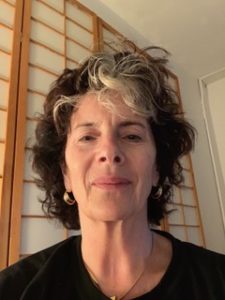My daughter Emma is straining to craft an identity separate from me.
At twenty-seven she is achieving this as she forges her life’s path. I admire that she is creating, designing with raw materials, making objects with her hands that are functional as well as beautiful. They are so different than my own, with their emphasis on the written word.
My girl is a woodworker, making her way in a world of primarily male craftsmanship. I trail behind her in the exotic wood emporium we visit occasionally to pick up her supplies. Proud as a peacock I watch her assessing the wood that she needs, measuring and sawing boards on foreboding, noisy machines. Cutting quite the figure in her tool belt and blue overalls, she tells me about the wood she has selected, the maple and the softwoods and, of course, the burled wood on display.
She is now launched, mostly independent. There is some feeling of loss for me, but I am feeling pleasure and accomplishment for her having reached this moment in her life. While at home in my kitchen, I touch a piece of jute, cord that appeals to me in its sturdiness and heft. At one time, the link between Emma and me was strong and unbreakable like the rough, jute cord. Time passes and she matures, and she needs a less robust link with me to develop into herself. A soft yarn connects us. She thrives as the connection is lessened, until eventually, only a fine diaphanous thread dangles between us. Still enduring but not nearly so hefty as the jute cord.
Suddenly I recall that when she was a young girl, maybe six- or seven- years old, she was like my little sidekick. That changed over time, as her friends became more important to her. But I adored that closeness, “Oh Mommy, I have so much to tell you!” I was her first confidante.
Now, I am not. And so, I strive to let go and to find my own place in this reconstituted order. I cradle a piece of burled wood in my city girl hands. Originating from a tree that was stressed, it is a round knotty growth that when polished will be full of swirls and beauty. I peel away the bark to investigate and marvel at the entangled splendour underneath. Craftspeople say that it can take thirty years for its full beauty to emerge.
The swirl of my burl is my life stories, my children, my joy and pain. Through my writing I shine a light on that jumble of memory, fact and emotion, searching for truth. Like my stories and myself, the burl wood grain is twisted and interlocked, resistant to splitting. I look upon it with wonder as it teaches me to find strength in its misshapenness.
I need that strength. In my interactions with my Emma I am constantly trying not to overstep, to respect the boundaries that she erects. It can be painful. Sometimes the edges feel like barriers but they can also melt away, as malleable as the situation commands.
***
I pick Emma up at the subway near my home. She is waiting there, slim, her light brown hair tossed by the wind. It’s a late September day as we set off for Ithaca, New York in the Finger Lakes District, about four hours from Toronto. Anticipating almost two weeks together for adventure, family and travel, we are both in good humour and easy with one another.
This has not always been the case. Earlier this year she pulled sharply away from me, not wanting any contact over a period of a few months. She was angry about something I’d done. It was a very painful interval, for both of us. By the time our road trip began we had healed somewhat, taken to seeing one another again and sharing aspects of our lives. The trip, I hope, will be a chance to cultivate and deepen our ease with one another.
The chair Emma designed and crafted, the primary reason for our trip, is braced safely in the back of the car. She conceived and built it at Sheridan College where she studied furniture craft and design. It is a unique piece, with an almost Scandinavian air,a fully wooden seat with no weaving or thatch. A beautiful, original rendering, it is now covered with care by an old grey baffled blanket. It awaits delivery to an exhibit space in Philadelphia. We wonder what we’ll be asked at the border, but they say nothing about the chair when I tell them we are on our way to visit my brother’s family there.
We meet my niece Sarah in Ithaca, where she is working on a doctorate in psychology at Cornell. First, we stop at the little Airbnb I’d reserved and drop off our things. Then we walk along a few tree-lined streets to the famed Moosewood Restaurant. Sarah is gracious. Seven months pregnant, red-haired and still generously freckled, she seems quite radiant over dinner. As imagined, the vegetarian food is tasty and wholesome, a seventies throwback for sure. I have most of their cookbooks and cherish fond memories of cooking from them in a co-op house with friends while at university.
We talk about Sarah’s program of study and how she expects they will manage the baby’s first year, with her husband Peter still in Philadelphia. She is upbeat and looking forward to the challenges ahead. Emma tells her about the chair and also the woodworking course she will be doing in Maine in another week’s time. I am pleased to see Emma and Sarah kibitz and bond together during our dinner. We haven’t always had close relations with their family and I hoped Emma would feel closer to them. When we’re saying goodbye, Emma buys a pale green baseball cap that sports the Moosewood logo, and Sarah wishes us good luck for our upcoming visit with her parents in Philly.
We blow in to Philadelphia the next day about four in the afternoon, just as Speaker Nancy Pelosi is declaring publicly for the first time that the U.S. House of Representatives will engage in impeachment hearings of the president. My brother is glued to the television, citing the historic moment, only moving slightly to snarl at me that I shouldn’t have parked where I did. Lynne, his wife, makes soothing noises and the exchange does not boil over, as it often does. I move the car.
Emma and Lynne ferry the chair to the garage where it can continue to off-gas from its finishing products. We offer to help with dinner but are shooed away to our respective rooms to rest. Emma looks up a climbing gym nearby on Google Maps and catches an Uber to work out for a couple of hours. Later, Lynne and I go for a much-needed invigorating walk in the community before dinner. Lots of old leafy trees and wide lawns are welcome indeed after two days of stressful highway driving. We work up a little sweat and the exercise helps bring me back down to earth. We talk about our kids, their lives and a little bit about the challenges of relationships with our respective partners.
The next morning, after a delicious breakfast of coffee, fresh berries and yogurt, we head into Philadelphia to deliver the chair. Lynne offers to drive, and so I do not need to navigate the city’s busy streets. We drive to the Center for Art in Wood in downtown Philadelphia. (The Center interprets, nurtures, and champions creative engagement and expansion of art, craft, and design in wood.) It is a beautiful, bright corner venue, with a showroom at the entrance. Emma does a little dance on the sidewalk with the chair held up in her arms and we follow her in, Lynne and I snapping photos all the way. We joke that we are her “paparazzi” and the Center staff laugh as we enter. Mission accomplished. The chair is delivered safely to the show “Making a Seat at the Table: Women Transform Woodworking,” a one-time very special exhibit. I am very proud of her for getting a spot in this ground-breaking show. Women in woodworking must fight for their place just as women in all fields. Now that her chair is welcomed and in place, we can continue our journey.
We spend another relaxing night at my brother’s having a barbecue dinner out on the patio, and then set off the next day toward upstate New York where we will visit Storm King Art Center. It is a 500-acre outdoor museum located in the Hudson Valley, where you can experience large-scale sculpture under open sky. Since 1960, Storm King has been dedicated to stewarding the hills, meadows, and forests of its site and surrounding landscape. Under a cloudless sky, we walk through the countryside, up and down hills, looking at the huge sculptures. We learn how the facility nurtures a vibrant bond between art, nature, and people, creating a place where discovery is limitless. One actually walks through some of the sculptures. It is a fabulous afternoon in the open air and Emma is in high spirits too.
The next day we venture to the gallery known as the Dia Beacon, also in upstate New York. Located in a former Nabisco box-printing factory, Dia Beacon presents Dia’s collection of art from the 1960’s to the present. It is a spacious gallery with very high ceilings and many impressive installations. We are playful, both enjoying this, as we snap photos of one another as we walk about the gallery. We’re having fun.
Emma is most taken by the work of American artist Richard Serra. Serra is one of the preeminent American artists and sculptors of the post-Abstract Expressionist period. His large-scale steel panel welded sculptures are remarkable and he suggests that art should be something “participatory” in modern society. That is, a gesture, or physical insertion into everyday life, not something confined to a cloistered museum space. “I love how you have to interact with his pieces and how sound, vision and space changes your mood depending on the undulations of each piece,” Emma wrote to me in answer to my questions about Serra. “When I was in Portugal where one of his large pieces is found, people were singing within the centre of the sculpture and it totally changed the experience.”
The following morning, we make our way to visit the Shaker Village in Hancock, Massachusetts. It is a former Shaker commune that was established by 1790 and active until 1960. It was the third of nineteen major Shaker villages established between 1774 and 1836 in New York, New England and other states. It is a nice day and we explore the different buildings and walk on a path into the woods at the side of the village. The buildings represent all the trades that would have contributed to the village’s commerce, including a hardware shop and blacksmith. Emma looks carefully at the tools in the woodworking shop and the assortment of tools.
Then we head off to Boston to see another of my nieces, Kaitlyn and her family. She is Sarah’s older sister. It is not an easy drive into the core of the city where they live. Some of the time, Emma is irritated by my weaknesses. We’re in a busy parking lot. It’s early evening and I’m having trouble seeing the parking signs. I have to rely on her to point them out. “I practically have to drive the damned car,” she charges. So, I’m not perfect, I think to myself. I wish she was more generous in her attitude toward me. Besides, she could learn to drive!
We park on their street and meet Kaitlyn and Paul at home and have drinks and snacks together on the balcony. It is a pleasure to play with Maya, who is almost two years old. Kaitlyn, an obstetrician herself, is pregnant with their second child, and that makes for some interesting conversation as they wonder how they will fit everyone into their modest apartment. It was great to see Emma connect with Kaitlyn and I feel that one of my goals for the trip has been met. Adult friendships have been rekindled with her cousins. I hope they will keep in touch in future. Later we walk to a family restaurant and have a nice meal, before saying goodnight and returning to our Airbnb.
We then have a two days’ drive to Maine. I think a lot about my relationship with Emma and the tensions between us. We talk a little, but nothing earthshattering. CBC Radio and podcasts keep us engaged. That night we stay at a sad-looking motel situated just off the highway. All night, you can hear the cars and trucks whizzing by. Emma looks on Google Maps for a climbing gym nearby and then goes out, leaving me to get settled. I decide to watch TV and check my Facebook account.
When she gets back she looks at me and says, “Did you take something? Your pupils are so dilated.” I feel hurt and say, “No, of course I haven’t”. I’m just feeling exhausted from all the driving and I suppose it shows in my face. I wonder if she thinks I’ve taken my medications incorrectly. We amble over to the little store next to the gas station to pick up a few items. I am still smarting from her accusation. She seems to settle down after that, but we don’t talk about her hurtful remarks. I cannot cross the boundary line she has erected without fear that I might lose her again. The lack of power I assign myself in the situation saddens me.
The reason Emma chose to be so distant from me last year stems from a first-person piece that I broadcast on public radio about my battles with depression. I had disclosed a suicide attempt that I made when Emma was just a few months old. Unfortunately, I did not prepare her adequately for the broadcast and so it was the first time she heard of it. She was both hurt and angry and wanted to know why I had not told her this before. I felt awful about it, not quite believing myself that I’d been so negligent not to tell her in person about that dismal period, before it was broadcast to the world. But I was trying to protect her at some level, and it backfired. Big time. I did not know, during those awful months of separation, if I would ever get her back.
The next day we careen along miles of highways, stopping on the way for Emma’s favourite, a delicious lobster tail sandwich, hoping to reach Rockport Maine and the Center for Furniture Craftsmanship by dark. It offers courses in furniture making and related skills such as carving, turning, and finishing and also houses the Messler Gallery whose mission is to advance design and craftsmanship in wood as a vibrant medium of expression. This artistic centre is her second major focus of the trip. We arrive minutes to dusk and Emma gets her camping equipment out of the car and organized so she can spend the night here. I admire her gumption. She is excited to start her course the next morning.
Once she has unpacked her gear, I continue to Camden, the next town over, to locate my Airbnb in the woods. I am looking forward to a restful few days as I am feeing quite anxious after so much highway driving and the underlying tension. I arrive at my much-needed pied à terre, park the car and unload. It is peaceful and still. My plan is to stay put, settle myself by walking every day, eating regularly and trying to write something.
I spend four quiet days in a lovely setting, warm against the elements. I listen to classical music on the local NPR station. I walk in the dense forest. The leaves are turning as autumn arrives in Maine. The woman who runs the Airbnb tells me that her late husband had been a woodworker and was associated with the Center where Emma is taking her class. We marvel at how small the world is.
I drive there one afternoon to drop off some rice for Emma and to see what she is working on. It is one of those funny moments in parenting when you realize that the kid who so badly wants to be grown up and separate calls upon you for help with their day-to-day affairs. Not unlike that wonderful book for the parents of teenagers called something like, “Now leave me alone. But first will you drive me to the mall?”
Emma shows me the pieces she has been working on, examples of multi-axis turning. I also take the opportunity to visit the Messler Gallery at the Center. It boasts several very accomplished pieces of work in wood and clay.
Five days later, I’ve scribbled many pages of notes. I’m a bit frustrated that I haven’t yet completed a more coherent piece. Emma comes and stays with me the last night so we can get up early for the long trip to Montreal the next day. At one point, we stop to relieve ourselves in a forest alongside the road. When it’s my turn, a woman yells from behind the trees, “Hey! It’s not a rest room.” I call back to her “It’s an emergency,” and then we scurry away down the highway. When we cross the border into Quebec in the mid-afternoon, the customs agent wants to make sure we don’t have any marijuana. This strikes us as kind of funny and we share a chuckle. We continue to downtown Montreal so Emma can visit her haunts and perhaps see a friend. A while back she had lived there for a year while studying dance. I elect to stay in the hotel room and read.
In the morning we walk to a nearby café for a coffee and croissant before leaving the city. We talk about our respective evenings the night before although we don’t share much. It is another six-hour drive before we’ll be home safely in Toronto. The ride is unremarkable, along the familiar 401 route. Passing the Big Apple Restaurant at the side of the highway near Trenton, we are getting closer to home. We are mostly quiet, listening to podcasts. When I drop Emma off at her house late that afternoon she does not hug me goodbye. I feel very sad about that, hurt and a bit irritated. I expected more from her. I’ve just driven her thousands of miles at not inconsiderable expense and I barely get a thank you. I feel disappointed.
It seems now with my adult daughter that I am always seeking to achieve a balance with her — between closeness and separation. It’s a tango of sorts, a passionate dance, and I don’t know the steps in advance. I am trying to let her go and I feel she is also seeking an equilibrium with me. It’s a dynamic process, sometimes hurtful, sometimes rewarding.
She is the swirl in my burl. Tapping a creative thread nurtured in her since always, she is becoming proficient in her chosen craft. A sphere so different from her parents’ vocation. In awe of her trajectory, I feel enormous pride as she launches away from me and moves through the world. Worry from our road trip slips away now. Unlike the tree when its burl is hacked away, she’s going to be all right.
About the Author

Miriam Edelson is a social activist, writer and mother living in Toronto, Canada. Her literary non-fiction, personal essays and commentaries have appeared in The Globe and Mail, Toronto Star, The Wascana Review, Collective Unrest, Writing Disorder, Wilderness House Literary Review and on CBC Radio. Her first book, “My Journey with Jake: A Memoir of Parenting and Disability” was published in April 2000. “Battle Cries: Justice for Kids with Special Needs” appeared in late 2005. She has completed a doctorate at University of Toronto focused upon Mental Health in the Workplace and is currently at work on a collection of essays. She lives with and manages the mental health challenges related to bipolar disorder.















